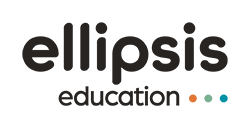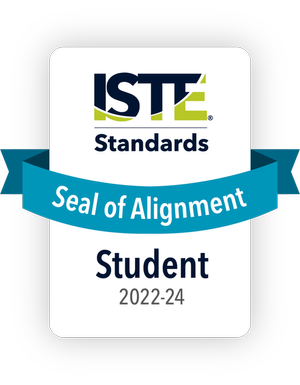Utah K-12 Computer Science Standards
Download a free 3-5 coding lesson that aligns with the Utah standards for computer science.
Ellipsis Education Computer Science Curriculum
Ellipsis Education computer science curriculum is grade-level differentiated, aligns with Utah state standards, and is continually updated to reflect changes in computer science. Since computer science is more than just coding, Ellipsis Education courses include coding, unplugged, digital citizenship, and STEM career lessons as well as hardware integrations.
Free Computer Science Lesson

COMPUTER SCIENCE LESSON PLANS
In this activity, students will use coordinates and coordinate planes to explore the functionality of the Scratch Motion blocks with the goal of animating a sprite to move around a treasure map. The downloadable lesson is aligned to Utah computer science standards and includes links to materials and resources, a detailed procedure, activity tips, and a bonus challenge activity. By the end of this lesson, students will be able to:
Utah Computer Science Standards
The Utah State Board of Education (USBE) developed the Utah Core Standards for computer science for grades K-12. The standards are derived from the K-12 Computer Science Framework. The Computer Science Core Standards are organized by grade level and into strands, or concepts, that represent what students must learn. The strands and associated standards can be found on the Utah Education Network standards (UEN standards) website.
For grades K-5, the strands are:
-
Computing Systems
-
Networks and the Internet
-
Data and Analysis
-
Computational Thinking
-
Impacts of Computing
-
Algorithms and Processing
For grades 6-12, the strands are the same as the 6 strands listed above with the exception of “Computational Thinking”. This is likely because the Computational Thinking standards should be mastered by all students by the time they advance to 6th grade.
The standards within each strand have core practices. These practices are what students will do to show mastery of the standard. In grades K-5, the practices are:
-
Fostering an Inclusive Computing Culture
-
Collaborating Around Computing
-
Creating Computational Artifacts
-
Testing and Refining Computational Artifacts
-
Recognizing and Defining Computational Problems
-
Communications About Computing
In grades 6-12, the practices are the same as the 6 practices listed above with the addition of “Developing and Using Abstractions”. This practice is likely added due to the complexity of the practice. Students need to develop a strong foundation of the other 6 practices before beginning to develop and use abstractions.
Additional STEM Utah Information
It is clear that the state of Utah values computer science and other STEM subjects. In addition to the UEN core standards for computer science, the state offers the following:
-
Digital studies: Students in grades 9-12 are required to take a digital studies course to graduate from high school. The approved digital studies courses are Business Office Specialist, Computer Programming, Computer Science Principles, Digital Business Applications, Exploring Computer Science, and Web Development.
-
Utah SEEd standards: These SEEd standards are essentially the Utah STEM standards; they aim to integrate engineering into science domains, such as the Utah earth science standards or chemistry standards.
These 4 implementations of Utah science core guides build on each other to provide a well rounded STEM experience for students. Utah went beyond the Common Core Standards to ensure that STEM was a priority for K12 learning. The core standards meaning does not just apply to Utah math and ELA, but for science and technology as well.
What Is Computer Science Education
The importance of computer science in education is clear as technology continues to advance. According to the Bureau of Labor Statistics, employment in computer and information technology occupations is projected to grow 11% from 2019 to 2029. Given this, shouldn’t we equip our students with these skills starting at a young age?
Currently, computer science programs are serving students as young as kindergarten all the way to high school. Most of these CS courses consist of a coding component, where students learn programming skills. The basic building blocks of coding such as loops, functions, and conditionals can be taught in elementary school and applied to more complex languages as students progress in their K-12 journey. As students attempt more advanced projects, such as developing websites, programs, and games, they are motivated to connect with their world and empowered to expand their skills. To get you started, check out this free coding lesson for grades K-2 that teaches programming skills and aligns with computer standards for elementary students.
Computer science education, however, is not only about coding. K 12 computer science also focuses on developing 21st century skills, such as the 4 C’s (communication, collaboration, computational thinking, and creativity). A strong foundation in these computer science skills will serve them well for years to come, regardless of the path they decide to pursue. We offer computer science professional development and training for K-12 teachers, including this free webinar about the 4 C’s.
Computer Science Education Requirements
Now that you have explored the Utah state computer science standards and understand the basics of computer science education, how can you get started? Perhaps you are new to teaching computer science and don’t know how to begin to focus your efforts. Perhaps you do have some experience and knowledge of the basics, but struggle with a curriculum progression that makes sense for your students. The pressure is on to deliver computer science knowledge to students that may know more than you! Luckily, there are a few baseline requirements that can help you create a computer science implementation plan.
The first part of your computer science implementation plan is your teachers. Finding passionate educators that will engage and learn alongside students is essential. Good news: your teachers do not have to have experience with computer science. Programming languages that come and go; there will always be something new on the horizon. One of the benefits of studying computer science is that having a strong foundation in certain concepts will be relevant for all languages and most applications going forward. Success in computer science is much more than just coding. It’s being a problem-solver, thinking critically, and having the ability to collaborate effectively with peers. Seeking growth in those essential skills is just as applicable for teachers as it is for students. There are many organizations that offer free educational events and communities for teachers interested in computer science. Furthermore, Ellipsis Education offers free professional development webinars that dive into different computer science subject areas.
Next, choose a curriculum that aligns with your school’s unique instructional strategy for computer science. There are multiple things to consider here.
-
Standards alignment: You want to align with the Utah K-12 computer science standards, which includes determining which lessons cover the standards, when they will be taught, and generating the alignment documentation.
-
Pacing: You want to establish fidelity of instruction across class periods, classrooms, and grade levels. You want a consistent curriculum for your teachers and students that is tailored to your scheduling needs.
-
Assessment methods: Students learn and demonstrate knowledge differently, so you want multiple ways to gain insight into your classroom, including summative and formative assessments.
-
Lesson plans: You want to make sure that lessons within the curriculum are scaffolded and paced to deliver student outcomes, and empower teachers to create an engaging student experience.
Finally, reflect on the values of teaching computer science. Our students are the most important consideration in any new program. You want to engage them, surprise them, and teach them the skills they need for their future. It is powerful to give students the opportunity to see a project come to life before their eyes. Enjoy watching your future computer science experts discover their potential!
Underneath “Related Articles” on this page, you can find other teaching computer science articles to help you on your journey.
Title I
If you are a Title I school in Utah, you may consider using your federal funds to purchase computer science curriculum.
WHAT IS TITLE I FUNDING?
Title I funds programming for low-income students. The money must go toward helping these students meet academic state standards. The amount of Title I funding distributed across the nation is available through the DOE website (most recently updated in 2017).
WHAT CAN TITLE I FUNDS BE SPENT ON?
Title I usage is based on the makeup of your student body. If 40% or more of your school’s students come from low-income families, Title I funds must be used on school-wide initiatives. These are known as Title I schools. If less than 40% of your school’s students come from low-income families, Title I funds must be used for programming that targets low-income students. It is important to note that Title I funds must go directly to low-income students, and the programs/materials cannot have been used in other classrooms first.
K 12 Computer Science Curriculum
Ellipsis Education provides full-year K-12 computer science curriculum that aligns with the Utah K-12 computer science standards. In addition, all Ellipsis Education courses have been awarded the ISTE Seal of Alignment. This seal means Ellipsis Education aligns with the ISTE standards and provides a high-quality, standards-aligned learning experience that enhances students’ digital age skills. The curriculum offers grade level differentiated learning pathways, aligns with all state and national computer science standards, and is continually updated to reflect changes in computer science. Ellipsis Education courses are customized to districts’ unique instructional strategy for computer science integration. This can mean incorporating computer science into an existing class period, adding to a specials rotation, or introducing a stand alone class. Courses are delivered with instructional resources teachers need to feel confident teaching computer science in K-12.
Our computer science curriculum for K-2 empowers you to engage your students with courses that fuel their interest. Coding lessons use ScratchJr, an introductory block coding language, perfect for emergent and early readers. In grades 3-5, inspire your students with courses that spark their creativity. Coding lessons use Scratch, a block based coding language, ideal for the transitional and fluent reader.
Our computer science curriculum middle school (6-8) helps you motivate your students with courses that connect to their world. Coding lessons use line based languages JavaScript, HTML, CSS, and Java to explore programming options.
Our computer science high school curriculum (9-12) helps you empower your students with courses that expand their skills. Coding lessons use JavaScript, Java, Python, and Godot to develop websites, programs, and games.
Explore our full k-12 computer science education course offering on our courses page. If any of these course options interest you, schedule a 30 minute call with one of our curriculum experts. Find the curriculum that will support every teacher as they inspire every student.
Computer Science Degree
After being introduced to computer science curriculum in K-12, students may be inspired to continue their computer science education. On a professional level, companies are recruiting for computer science degree jobs in cloud computing, app development, and statistical analysis. On an individual level, computational thinking, problem solving, and relationship building are all deeply influenced by computer science. This understanding of computer science jobs leads to much broader applications. you don’t necessarily need a degree in computer science; anyone that uses technology to solve problems can be considered a computer scientist!
Introducing computer science in the K-12 experience opens doors for students to pursue a computer science degree in college. The top computer science colleges in Utah, including Brigham Young University, University of Utah, MTECH, and Utah State University offer concentrations in various areas of computer science, like computer information systems, information technology, computer software and applications, and computer systems networking. The reality is, though, students do not need to attend a top university to pursue these computer science majors. Even non-STEM majors, like business, biology, and English use computer science skills to communicate ideas.
Likewise, computer science skills taught in K-12 can be applied directly to any career students pursue after high school. Computational thinking, problem solving, and teamwork can be applied in trades (like electrician, plumber, and HVAC) and other positions (like retail, restaurants, and reception).
Ellipsis Education spotlights the many forms of computer science careers in our My STEM Career podcast. In these interviews, hear from professionals, students, and teachers as they share how they built confidence in their computer science skills. Two particularly interesting interviews include Will Muto, a Product Technical Director at Industrial Light and Magic, who worked on Star Wars films, and Alia Enos, Software Developer II at 343 Industries, who works on the Halo video game series. In addition, Ellipsis Education offers free STEM career lessons, including this one that aligns with high school computer science standards.
STEM Standards PDF

COMPUTER SCIENCE LESSON PLANS
In this activity, students will use coordinates and coordinate planes to explore the functionality of the Scratch Motion blocks with the goal of animating a sprite to move around a treasure map. This lesson is built for grades 3 – 5 and introduces coding for kids: Scratch, a block based coding language.
The downloadable lesson is aligned to Utah computer science standards and Utah math standards. It includes links to the appropriate materials and resources, a detailed procedure, activity tips, and a bonus challenge activity.

